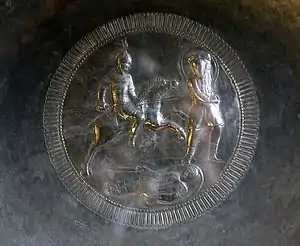Isola Rizza dish
The Isola Rizza dish is a sixth-century silver dish with a relief medallion in the centre depicting a scene of warfare.[1] It was part of a hoard discovered by a local in a field near the parish church in Isola Rizza in the winter of 1873. Besides the dish, the hoard contained six silver spoons, two silver and gold disc fibulae with filigree, a belt clasp and three golden belt fittings. The clasp and one fitting are now lost, but the dish is kept in the Castelvecchio Museum. Numerous copies have been made.[2]

.jpg.webp)
The dish is generally dated to the late sixth century.[2] Stylistically, it is a Byzantine work,[1] possibly produced in Italy.[2] It depicts a scene from either the Gothic Wars[3][4] or the Lombard Wars in Italy.[2][5] The burial of the hoard may be associated with the Lombard capture of Verona in 569.[1]
The relief medallion of the dish shows a heavy cavalryman charging one infantryman while leaping over a fallen one. The cavalryman wears a Spangenhelm-style helmet and lamellar armour, and is wielding a contus (long spear). He is most likely a Germanic or Alan mercenary in Byzantine service,[2] possibly a cataphract.[3] The two infantryman carry round shields and spathae (swords).[2] They have beards, trousers and tunics.[2][1] They have generally been seen as Lombards, although that implies a later dating for the hoard than 569.[1]
References
- Neil Christie (1991), "Longobard Weaponry and Warfare, AD 1–800", Journal of Roman Military Equipment Studies 2: 1–26.
- Gabriele Esposito (2014), "The Isola Rizza Dish", Medieval Warfare 4(6): 58. doi:10.2307/48578403
- Gergely Csiky (2015), Avar-Age Polearms and Edged Weapons: Classification, Typology, Chronology and Technology (Brill), p. 395 n32.
- Neil Christie (2006), From Constantine to Charlemagne: An Archaeology of Italy, AD 300–800 (Ashgate), p. 353.
- Guy Halsall (2003), Warfare and Society in the Barbarian West, 450–900 (Routledge), p. 169.